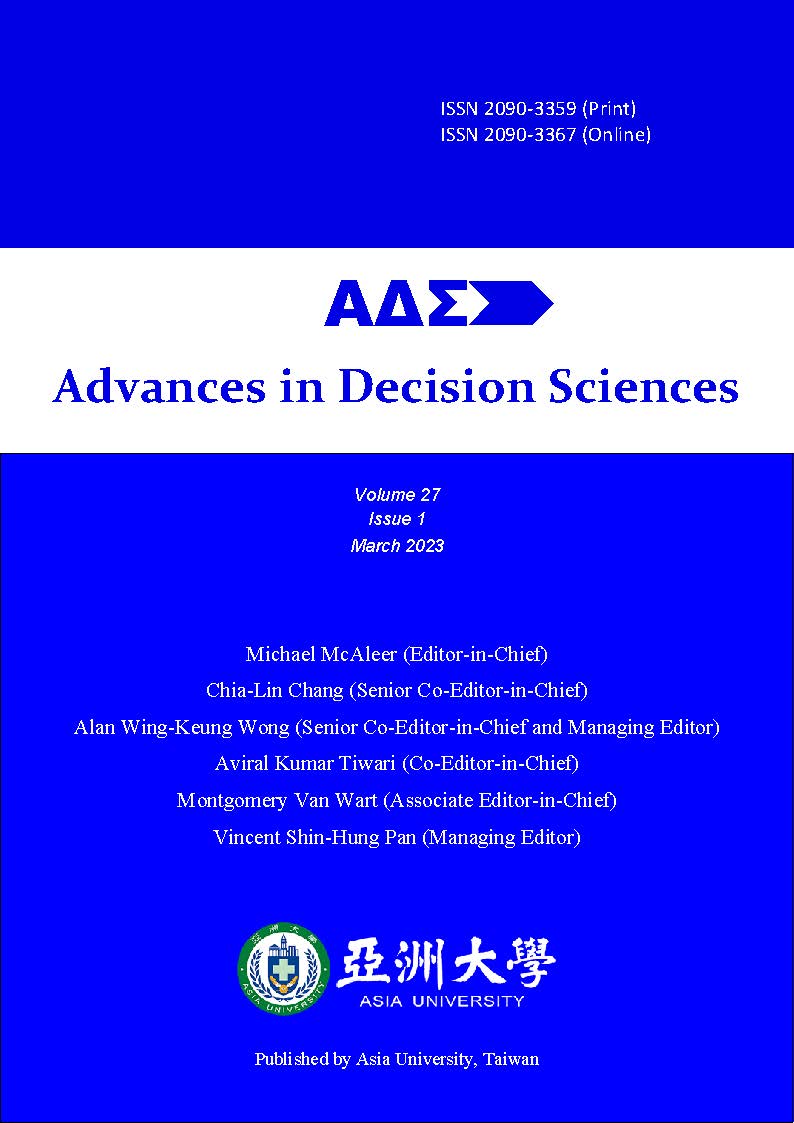Impact of cashless bank payments on economic growth: Evidence from G7 countries
DOI:
https://doi.org/10.47654/v27y2023i1p1-22Keywords:
Cashless bank payments, economic growth,, G7 countries,, Panel ARDL,, cashless society,, digital finance,, financial inclusionAbstract
This paper examines the impact of cashless payments on the economic growth of G7 countries, namely Canada, Germany, Japan, France, Italy, the United Kingdom and the United States. The paper employed annual data from 2012 to 2020 and the latest Panel ARDL model to examine the relationship described above. The study's findings suggest that the cashless mode of payments considered in this study, which includes card & e-money, credit transfer and cheque, have a strong positive relationship with the real GDP of G7 countries. Further, future comprehensive research is recommended, including developing nations. At the same time, the institutions and governments should contribute by ensuring the availability of relevant facts and figures.
References
Ali, W., Gohar, R., Chang, B. H., & Wong, W. K. (2022). Revisiting the impacts of globalization, renewable energy consumption, and economic growth on environmental quality in South Asia. Advances in Decision Sciences, 26(3), 78-98.
Aminata, J., & Sjarif, G. E. (2020). Towards a cashless society in indonesia: The impact on economic growth and interest rate. Indonesian Journal of Economics, Entrepreneurship, and Innovation, 1(2), 62-68.
Arun, T., & Kamath, R. (2015). Financial inclusion: Policies and practices. IIMB Management Review, 27(4), 267-287.
Asteriou, D., Pilbeam, K., &Pratiwi, C. E. (2021). Public debt and economic growth: panel data evidence for Asian countries. Journal of Economics and Finance, 45(2), 270-287.
Attard, J. (2019). Public Debt and economic growth nexus: a dynamic panel ARDL approach.
Bwigenge, S., Sensuse, D. I., &Suryono, R. R. (2020, October). Passengers Acceptance of Cashless Payment System for Public Bus Transportation System in Kigali City (Rwanda). In 2020 International Conference on Advanced Computer Science and Information Systems (ICACSIS), 341-350
Chang, B. H., Gohar, R., Derindag, O. F., & Uche, E. (2022a). COVID-19, lockdown measures and their impact on food and healthcare prices: empirical evidence using a dynamic ARDL model. Journal of Economic Studies, (ahead-of-print).
Chang, B. H., Derindag, O. F., Hacievliyagil, N., & Canakci, M. (2022b). Exchange rate response to economic policy uncertainty: evidence beyond asymmetry. Humanities and Social Sciences Communications, 9(1), 1-14.
Chang, B. H., and Rajput, S. K. O. (2018). Do the changes in macroeconomic variables have a symmetric or asymmetric effect on stock prices? Evidence from Pakistan. South Asian Journal of Business Studies, 7(3), 312-331.
Chang, B. H., Meo, M. S., Syed, Q. R., & Abro, Z. (2019a). Dynamic analysis of the relationship between stock prices and macroeconomic variables. South Asian Journal of Business Studies, 8(3), 229-245.
Chang, B. H., Rajput, S. K. O., and Bhutto, N. A. (2020a). The asymmetric effect of extreme changes in the exchange rate volatility on the US imports: Evidence from multiple threshold nonlinear ARDL model. Studies in economics and finance
Chang, B. H., Sharif, A., Aman, A., Suki, N. M., Salman, A., and Khan, S. A. R. (2020b). The asymmetric effects of oil price on sectoral Islamic stocks: New evidence from quantile-on-quantile regression approach. Resources Policy, 65, 101571.
Chang, B. H., Rajput, S. K. O., Ahmed, P., & Hayat, Z. (2020c). Does Gold Act as a Hedge or a Safe Haven? Evidence from Pakistan. The Pakistan Development Review, 59(1), 69-80.
Chang, B. H. (2020). Oil prices and E7 stock prices: an asymmetric evidence using multiple threshold nonlinear ARDL model. Environmental Science and Pollution Research, 1-12.
Chang, B. H., Rajput, S. K. O., & Bhutto, N. A. (2019b). Impact of exchange rate volatility on the US exports: a new evidence from multiple threshold nonlinear ARDL model. Journal of International Commerce, Economics and Policy, 10(02), 1950009.
Chang, B. H., Rajput, S. K. O., and Ghumro, N. H. (2018). Asymmetric impact of exchange rate changes on the trade balance: Does global financial crisis matter? Annals of Financial Economics, 1850015.
Cashless society (n.d.). Cashless society. Business novice website. [Accessed date: 2022, April 12, 10:00am] https://businessnovice.net/definition/cashless-society/
Darsono, S. N. A. C., Wong, W. K., Nguyen, T. T. H., Jati, H. F., & Dewanti, D. S. (2022). Good Governance and Sustainable Investment: The Effects of Governance Indicators on Stock Market Returns. Advances in Decision Sciences, 26(1), 69-101.
Derindag, O. F., Chang, B. H., Gohar, R., & Salman, A. (2022). Exchange Rate Effect on the Household Consumption in BRICST Countries: Evidence from MATNARDL Model. Journal of International Commerce, Economics and Policy, 2250010.
Fabris, N. (2019). Cashless society–the future of money or a utopia?. Journal of Central Banking Theory and Practice, 8(1), 53-66.
Fortune business insights (n.d.). Technology & Media/Digital payment market. Fortune business insights. [Accessed date: 2022, May 11, 2:15pm] https://www.fortunebusinessinsights.com/digital-payment-market-101972
Garidzirai, R., & Muzindutsi, P. F. (2020). A panel ARDL analysis of the productivity of key economic sectors contributing to local economic growth in an emerging country. Studia Universitatis Babes-Bolyai, Oeconomica, 65(1).
Ghanem, E. at al (2021), World payment reports 2021. https://worldpaymentsreport.com/wp-content/uploads/sites/5/2021/10/World-Payments-Report_2021_Web.pdf
Givelyn, I., Rohima, S., Mardalena, M., & Widyanata, F. (2022). The Impact of Cashless Payment on Indonesian Economy: Before and During Covid-19 Pandemic. Jurnal Ekonomi Pembangunan, 20(1), 89-104.
GOHAR, R., BAGADEEM, S., CHANG, B. H., & ZONG, M. (2022a). DO THE INCOME AND PRICE CHANGES AFFECT CONSUMPTION IN THE EMERGING 7 COUNTRIES? EMPIRICAL EVIDENCE USING QUANTILE ARDL MODEL. Annals of Financial Economics, 2250024.
Gohar, R., Bhatty, K., Osman, M., Wong, W. K., & Chang, B. H. (2022b). Oil prices and sectorial stock indices of Pakistan: Empirical evidence using bootstrap ARDL model. Advances in Decision Sciences, 26(4), 1-27.
GOHAR, R., SALMAN, A., UCHE, E., DERINDAG, O. F., & CHANG, B. H. (2022c). DOES US INFECTIOUS DISEASE EQUITY MARKET VOLATILITY INDEX PREDICT G7 STOCK RETURNS? EVIDENCE BEYOND SYMMETRY. Annals of Financial Economics, 2250028.
Gohar, R., Chang, B. H., Derindag, O. F., & Abro, Z. (2022d) Nexus between Consumption, Income, and Price Changes: Asymmetric Evidence from NARDL Model.
Grzelczak, M., &Pastusiak, R. (2020). Cashless Payments and Economic Growth in Selected European Countries. AnnalesUniversitatisMariae Curie-Skłodowska, sectio H–Oeconomia, 54(3), 33-46.
Gupta, P., &Hakhu, R. (2021). An empirical analysis of customer perception towards cashless transactions: A case study of Haryana. IJAR, 7(12), 01-06.
Hasan, I., De Renzis, T., &Schmiedel, H. (2012). Retail payments and economic growth. Bank of Finland research discussion paper, (19), 1-37
Hashmi, S. M., & Chang, B. H. (2021) Asymmetric effect of macroeconomic variables on the emerging stock indices: A quantile ARDL approach. International Journal of Finance & Economics. https://doi.org/10.1002/ijfe.2461.
Hashmi, S. M., Chang, B. H., & Shahbaz, M. (2021b). Asymmetric effect of exchange rate volatility on India's cross‐border trade: Evidence from global financial crisis and multiple threshold nonlinear autoregressive distributed lag model. Australian Economic Papers, 60(1), 64-97.
Hashmi, S.M., Chang, B.H. and Rong, L. (2021b). Asymmetric effect of COVID-19 pandemic on E7 stock indices: Evidence from quantile-on-quantile regression approach. Research in International Business and Finance, 58, p.101485.
Hashmi, S. M., Chang, B. H., Huang, L., & Uche, E. (2022). Revisiting the relationship between oil prices, exchange rate, and stock prices: An application of quantile ARDL model. Resources Policy, 75, 102543.
Hsiao C. (2006) Panel Data Analysis: Advantages and Challenges, Sociedad de Estad´ıstica e Investigaci'on Operativa, 7 (2), 1-63.
IGI Global (n.d.). What is ARDL Model? IGI Global. [Accessed Date: 2022, May 09, 11am] https://www.igi-global.com/dictionary/ardl-model/55662Koh, F., Phoon, K. F., & Ha, C. D. (2018). Digital financial inclusion in South east Asia. In Handbook of Blockchain, Digital Finance, and Inclusion, 2, 387-403.
Kim, H. J. (2021). Social Media and Analytics: A Case Study of Tweets Data. Advances in Decision Sciences, 25(2), 1-22.
Kumari, N., & Khanna, J. (2017). Cashless payment: A behaviourial change to economic growth. Qualitative and Quantitative Research Review, 2(2), 82-103
Latif, N. W. A., Abdullah, Z., &Razdi, M. A. M. (2015). An autoregressive distributed lag (ARDL) analysis of the nexus between savings and investment in the three Asian economies. The Journal of Developing Areas, 323-334.
Luburić, R. and Fabris, N. (2014). Umijeće upravljanja novcem. Podgorica: Medeon.
Lyman, T & Lauer, K (2015). What is digital financial inclusion and why does it matter? CGAP. [Accessed Date: 2022, May 11, 1:30pm] https://www.cgap.org/blog/what-digital-financial-inclusion-and-why-does-it-matter
Maydybura, A., Gohar, R., Salman, A., Wong, W. K., & Chang, B. H. (2022). The Asymmetric Effect of the Extreme Changes in the Economic Policy Uncertainty on the Exchange Rates: Evidence from Emerging Seven Countries. Annals of Financial Economics, 2250031.
Maghyereh, A.I., Abdoh, H. 2022. Connectedness between Crude Oil and US Equities: The Impact of COVID-19 Pandemic. Annals of Financial Economics, 2250029.
Myovella, G., Karacuka, M., &Haucap, J. (2020). Digitalization and economic growth: A comparative analysis of Sub-Saharan Africa and OECD economies. Telecommunications Policy, 44(2), 101-856.
Nasrullah, M., Rizwanullah, M., Yu, X., Jo, H., Sohail, M. T., & Liang, L. (2021). Autoregressive distributed lag (ARDL) approach to study the impact of climate change and other factors on rice production in South Korea. Journal of Water and Climate Change, 12(6), 2256-2270.
Ozili, P. K. (2018). Impact of digital finance on financial inclusion and stability. Borsa Istanbul Review, 18(4), 329-340.
Ozturk, A. B. (2016). Customer acceptance of cashless payment systems in the hospitality industry. International Journal of Contemporary Hospitality Management. 28(4)
Patwardhan, A. (2018). Financial inclusion in the digital age. In Handbook of Blockchain, Digital Finance, and Inclusion, 1, 57-89.
Peng, B., Chang, B. H., Yang, L., & Zhu, C. (2022). Exchange rate and energy demand in G7 countries: Fresh insights from Quantile ARDL model. Energy Strategy Reviews, 44, 100986.
Rahman, H., Shafique, M. N., Khurshid, M. M., Asghar, M. S., & Ghafoor, S. (2020). Factors influencing Digital Payments adoption in Pakistan. Sarhad Journal of Management Sciences, 6(1), 69-80.
Ropheka, E., &Miapkwap, K. D. (2020). IMPACT OF CASHLESS BANKING POLICY ON THE ECONOMIC GROWTH OF NIGERIA. Bingham Journal of Economics and Allied Studies. 4(2), 2645-3045
Sreenu, N. (2020). Cashless payment policy and its effects on economic growth of India: an exploratory study. ACM Transactions on Management Information Systems (TMIS), 11(3), 1-10.
Syed, Q. R., Malik, W. S., & Chang, B. H. (2019). Volatility Spillover Effect of Federal Reserve’S Balance Sheet On The Financial And Goods Markets Of Indo-Pak Region. Annals of Financial Economics, 14(03), 1950015.
TajMazinani, M., Hassani, H., & Raei, R. (2022). A Comprehensive Review of Stock Price Prediction Using Text Mining. Advances in Decision Sciences, 26(2), 116-152.
Tennant, F (2021). Cashless society: the future of digital payments. Financier worldwide. [Accessed Date: 2022, May 11, 2:00pm] https://www.financierworldwide.com/cashless-society-the-future-of-digital-payments#.Ypo8HahBzIW
Uche, E., Chang, B. H., & Effiom, L. (2022a) Household consumption and exchange rate extreme dynamics: Multiple asymmetric threshold non‐linear autoregressive distributed lag model perspective. International Journal of Finance & Economics.
Uche, E., Chang, B. H., & Gohar, R. (2022b). Consumption optimization in G7 countries: Evidence of heterogeneous asymmetry in income and price differentials. Journal of International Commerce, Economics and Policy, 13(1), 2250002.
Wang, X., Chang, B. H., Uche, E., & Zhao, Q. (2022). The asymmetric effect of income and price changes on the consumption expenditures: evidence from G7 countries using nonlinear bounds testing approach. Portuguese Economic Journal, 1-19.
Wong, T. L., Lau, W. Y., & Yip, T. M. (2020). Cashless Payments and Economic Growth: Evidence from Selected OECD Countries. Journal of Central Banking Theory and Practice, 9(s1), 189-213.
World bank (2022). Financial inclusion. World Bank. [Accessed Date: 2022, May 15, 9:45am] https://www.worldbank.org/en/topic/financialinclusion/overview#1
Xena, P., &Rahadi, R. A. (2019). Adoption of e-payment to support small medium enterprise payment system: A conceptualised model. International Journal of Accounting, 4(18), 32-41.
Yusuf, I. (2016). Cash-less policy and economic growth: evidence from Nigeria. International Journal of Electronic Finance, 9(1), 63-71.
Zandi, M., Singh, V., & Irving, J. (2013). The impact of electronic payments on economic growth. Moody’s Analytics: Economic and Consumer Credit Analytics, 217(2).

Published
Issue
Section
License
Copyright (c) 2023 Advances in Decision Sciences

This work is licensed under a Creative Commons Attribution-NonCommercial 4.0 International License.







 Scientific and Business World
Scientific and Business World